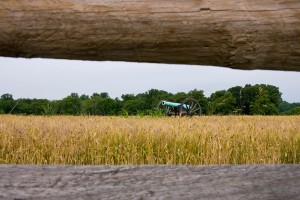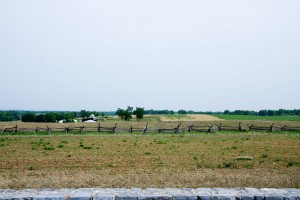 Wars are about attrition. They start out with patriotic slogans, promises to protect those who can’t protect themselves, or the notion of righting horrific wrongs, but the series of battles themselves come down to attrition: each side kills as many of the other side until one has lost too many lives or they’ve expended all of their resources in the contest, and they then surrender. That’s it, and it’s rarely more evident than in the Civil War (although World War I has my vote for the most effective campaign to thin humanity’s population), and there’s no greater monument to the loss of life in the Civil War than the Battle of Antietam.
Wars are about attrition. They start out with patriotic slogans, promises to protect those who can’t protect themselves, or the notion of righting horrific wrongs, but the series of battles themselves come down to attrition: each side kills as many of the other side until one has lost too many lives or they’ve expended all of their resources in the contest, and they then surrender. That’s it, and it’s rarely more evident than in the Civil War (although World War I has my vote for the most effective campaign to thin humanity’s population), and there’s no greater monument to the loss of life in the Civil War than the Battle of Antietam.
Following the Battle of South Mountain, Union General McClellan had the Confederate armies on the run. With units scattered all over the countryside, McClellan brought his forces to the banks of the Antietam creek as early as September 15th. And then he waited. Never one to “rush into” anything, and always fearing he was outnumbered – he never was, not once — McClellan studied the lay of the land, gathered his forces, made his plans, consulted with his staff, and he waited. On September 15th, it’s estimated that Lee only had about 18,000 men in his army at Antietam. By the time McClellan finally attacked on September 17th, Lee had gathered enough of his army to have approximately 40,000 men on the line. Still not nearly McClellan’s 75,000, but over double what he’d had on the 15th, and as the defensive fell to Lee, the added numbers would tell greatly.
The members of the newly named Iron Brigade spent the night of September 14th in and around the battle field of South Mountain, sleeping where they fell amongst the dead and dying. The 15th found them marching for Sharpsburg, the town near the Antietam creek, and the name by which the Confederacy would know the coming battle. They arrived in the area and spent that day and the next resting when they could, counting their casualties from the latest battle, and reorganizing. Even though they had only been in real combat the first time less than a month prior, the unit was severely depleted. The 19th Indiana, for example, had lost so many officers that four of the companies had to be commanded by enlisted men, some companies were down from the official strength of 100 men to only two dozen, and their commanding officer, Sol Meredith, had to relinquish command due to debilitating pain from the broken ribs he’d received at Brawner’s Farm the month before.
Alan D. Gaff focuses on the 19th Indiana in his book, “On Many a Bloody Field”. Gaff, the author of the previously mentioned “Brave Men’s Tears”. “On Many a Bloody Field” relates the experiences of the 19th from their formation in 1861 through the end of the war at Appomattox. Told with the same attention to detail, exhaustive research, and focus on the common soldier’s experiences, it’s a large, 520 page, trove of information on the unit. His chapter on Antietam and the 19th’s experiences is one of the highlights of the book. One can feel the weariness and confusion of the men in the unit as they struggle to come to terms with what has happened, and prepare for what is to come.
It was with these depleted numbers and weariness that the Iron Brigade slept in a field near Sharpsburg, in a freshly plowed field under a drizzling rain the night of September 16th. They were awakened before the sun had even begun to think of rising, to start moving by 5:30 a.m. They set out towards their objective of the Dunker Church, partly because it was in the vicinity of their target area, but also because it was so dark that the white church, almost glowing with what little light it could pull from the darkness, was the only landmark that could be seen at that early hour.
The fields at Antietam are like no farmland you likely have ever seen. In the middle of a cornfield the ground will simply drop away into a crevice, deep enough to lose an entire squad of men in, or a large boulder will just out of the land in the middle of nowhere. I’ve never seen anything like it; in some parts it’s a chore to even hike it even now without twisting an ankle. I can’t imagine a worse place through which to move 19th century troops. Indeed, many commanders at Antietam said that it was harder to keep tabs on their troops there than anywhere else: the topography caused more confusion than the sounds and smoke of the battle.
Half of the Iron Brigade advanced through a cornfield. An ordinary field that morning, the place would take on the proper noun name of The Cornfield by the end of the battle. “There were shot, shells, and Minie balls sweeping the face of the earth; legs, arms, and other parts of human bodies were flying in the air like straw in a whirlwind,” a survivor said of the place. The other half of the brigade advanced up through a wooded lot and along a stone fence, until the 19th Indiana, engaged in firing into the flanks of several Confederate units, charged forward under their commander’s orders to seize abandoned Confederate cannons. Southern reinforcements coming into the battle caught them at point-blank  range and killed Lt. Colonel Bachman, who had taken over command of the unit just days prior, and made casualties of over half of the 19th Indiana’s 200 men. The rest of the brigade took heavy casualties as well. The Cornfield had started the day as a fully grown crop of stalks over a man’s height — the only way Union men knew the Confederates were near was that they could see the tips of their rifles sticking up above the stalks — but as the field changed hands over a half-dozen times during the morning, the bullets and shells destroyed the stalks so that “they were cut closer to the ground than if a scythe had passed over the entire lot”. Indeed, even the cut-off stalks were difficult to see amid the dead men and animal bodies, the severed limbs, and the splattered gore mixed with the plant matter.
range and killed Lt. Colonel Bachman, who had taken over command of the unit just days prior, and made casualties of over half of the 19th Indiana’s 200 men. The rest of the brigade took heavy casualties as well. The Cornfield had started the day as a fully grown crop of stalks over a man’s height — the only way Union men knew the Confederates were near was that they could see the tips of their rifles sticking up above the stalks — but as the field changed hands over a half-dozen times during the morning, the bullets and shells destroyed the stalks so that “they were cut closer to the ground than if a scythe had passed over the entire lot”. Indeed, even the cut-off stalks were difficult to see amid the dead men and animal bodies, the severed limbs, and the splattered gore mixed with the plant matter.
The Battle of Antietam happened in three distinct stages, and the northern fields and woods were nearly silent by lunch time that day, as the fight moved along the armies’ lines to the south. If the Iron Brigade had been depleted at the start of the fight, it was nearly decimated after it. All told, as both sides recuperated from the fight over the next few days, the entire brigade only mustered about 400 men fit for duty. Much has been made of McClellan’s unwillingness to follow up on the victory at Antietam and follow Lee to finish him off, and there may well have been units that could have done so — the cavalry and an entire corps saw little or no fighting on the 14th — but units that did fight, such as the Iron Brigade, were simply too used up.
The question is always “what if?” What if Lee had been defeated at Antietam decisively, even captured? Would that have ended the war? Doubtful. As I said, it’s all about attrition. The Confederacy had been on a winning streak before the invasion of Maryland, and a defeat at Antietam wouldn’t have left them hopeless. The Confederacy still had armies in Virginia and further south, and thousands of men in armies in the Western theatre. Much like the Iron Brigade would rest, recover, and draw some reinforcements, and live to fight another day, the South would have recovered from a crushing defeat at Antietam in the same way. Even with the massive casualties at Antietam (the most deadly single day of combat in American history, with over 22,000 casualties*, combined), another two and a half years of attrition, hardships, and death would be needed to break the will of the southern leadership and make the wisest of them realize that it was a war they could not win. There would be victories for them before that happened — some of them major — but they could never overcome the reality of the rapid draining of resources and men on both sides: a draining that the North could easily absorb, but one that the South could not afford.
For photos of the battleground at Antietam, the 19th Indian website has posted a series of them that I took during a visit several years ago.
*it’s a common error to think the word casualties refers to those killed. It actually is the number of all killed, wounded, captured, and missing. The number of outright killed at Antietam is actually around 4,000, but that number is uncertain as men continued to die from their wounds months, even years, after the battles of the Civil War.
Nice writing Devon!!